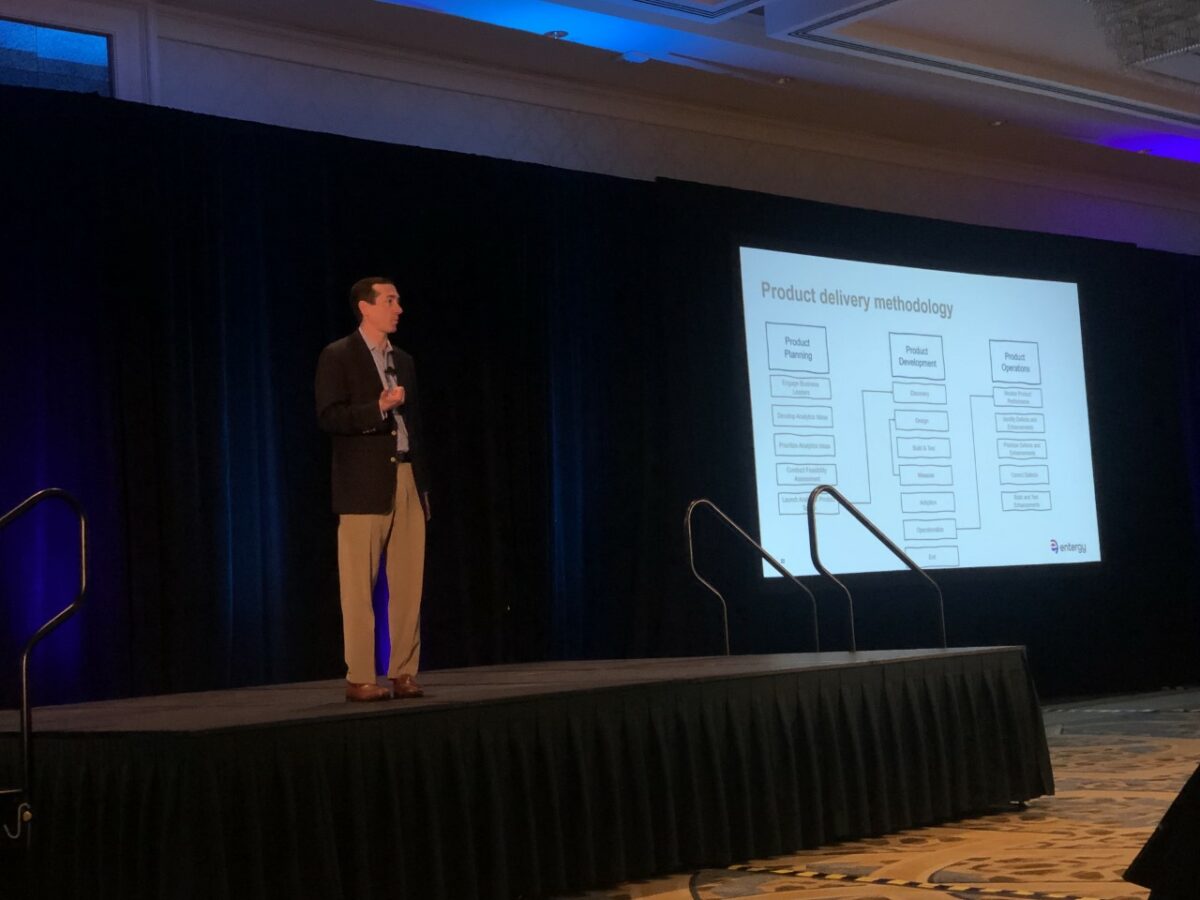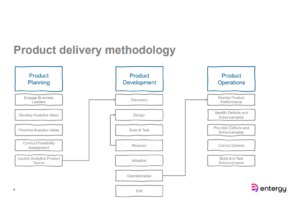
Entergy’s Andy Quick uses UA Summit 2022 keynote to talk about launching and sustaining a successful analytics function.
May 11, 2022, New Orleans – Andy Quick, vice president of business data & insights kicked off Day 2 of UA Summit 2022 with his keynote session, “Moneyball for Utilities”. Quick, who has been with Entergy for twenty-six years, only took on this role last year in August. He proclaims to not be an expert in in the area–despite having a computer science degree from Louisiana State University, worked as an adjunct robotic process automation instructor at Tulane University and University of New Orleans, and formerly led the development of a new digital platform business for Entergy.
Quick’s presentation covered three main topics:
- Creating an identity for the enterprise analytics team
- Implementing a product pipeline
- Establishing an organizational structure
The storyline of the session was based on the movie Moneyball starring Brad Pitt and Jonah Hill. For those that are not familiar with the film, it tells the story of the Oakland A’s 2002 season and their manager Billy Bean (Brad Pitt) and assistant general manager Peter Brand (Jonah Hill) who revolutionized baseball’s player acquisition and game strategy through data and analytics. Brand, a young Yale economics graduate, had revolutionary ideas about how to evaluate players and convinced Bean to take on the information-driven strategy. He would be the numbers guy and Bean would be the baseball guy.
Now a standard practice in the MLB, Bean and Brand faced mockery in the media and skepticism from their own organization testing their out-of-the-box approach. Ultimately, Bean and Brand succeeded in their mission and A’s management bought into their process. Quick says this is the same challenge utilities analytics teams face: selling their analytics first approach to business executives. He decided to use the movie as an analogy to explain the potential of his team to the business leaders. He pitched them, and they loved it.
Creating an identity
When Quick stepped into the vice president of business data and insights position, it was apparent the enterprise analytics team needed to define their lane and create an identity. Other business groups did not know the purpose or function of the enterprise analytics team. During hallway encounters he heard a plethora of names used to reference the group.
Quick and the team decided they would pick a single focus area: predictive analytics. They would use predictive analytics to inform business leaders with information to make decisions—they would become the Peter Brand to the business leaders (Billy Bean). With this new identity, they defined two main functions:
- Create and maintain analytics products
- Provide enterprise data services
Quick’s presentation focused on the product pipeline they built to continuously create and maintain analytics products.
Implementing a Product Pipeline and Delivery Methodology
To continuously create and maintain product, Quick knew the enterprise analytics team needed to create a product pipeline. However, with so many business functions to support, it was going to be a challenge to create a process that allowed them to take on projects from the different business departments and prioritize them. They started with one-on-one interviews—lots of them.
Quick’s team conducted eighty-five interviews with business leaders to understand what problems they could help remedy using analytics. These interviews generated 122 ideas from across the whole enterprise. With such a large pool of ideas, the enterprise analytics team knew they needed a method to classify and prioritize all these potential projects. They started by charting the projects on a chart where the x-axis represented effort and the y-axis represented value. Unfortunately, Quick mentions, none of the projects turned out to be the proverbial low-hanging fruit—low effort, high value.
They also grouped all the projects into four domains: customer, power delivery, generation, and corporate. Once the enterprise analytics team grouped the projects, they prioritized each of them within the domains. Quick notes this was easier said than done; it took substantial time and consideration to determine what was a top priority project.
This process—interview, classify and group, prioritize—became the product pipeline.
Now that Quick’s team established a product pipeline, they knew they needed to build out a delivery methodology to continuously create and maintain products. They decided on a process that relies on three main pillars: product planning, product development, and product operations. Each pillar has its own set of steps that are executed before moving onto the next (Figure 1).
The enterprise analytics team created this product delivery methodology from scratch. They started fresh because they wanted to implement a repeatable delivery process that was specific to their needs and could scale in the future. It was consequential they get it right.
Establishing an Organizational Structure
To make scaling easier, the enterprise analytics team organized into smaller product teams, or “pods.” These pods are responsible for seeing an individual product through the product pipeline and delivery process. Establishing small, nimble pods created a sense of ownership over each product and allowed the enterprise analytics team to run multiple projects simultaneously.
Each pod consists of four, dedicated full time members. These are the business analytics manager, the product manager, a data scientist, and a data engineer. Quick says the product manager plays the role of Peter Brand—owns the analytics process and delivers results. The Business Analytics Mangers acts as Billy Bean—the insights person who takes the numbers out of the abstract and puts them into the context of the business.
Other roles work with the pods but are not dedicated to a single pod. They include a business sponsor and additional business experts, whose responsibilities include testing and validating the product and acting as the champion of adoption for the business. There is also a group of roles called “cross-pod” that work with all the individual product teams. These cross-pod roles are the product designer, solution architect and software engineer.
The Moneyball
Quick ran with the Moneyball analogy because it is relatable and clearly communicates his team’s mission: to help business leaders win by enabling them to make decisions today using predictions about the future. Using this analogy, Quick secured executive buy-in to build a new product pipeline and delivery methodology that continuously delivers results and is well-suited to scale in the future.
Quick wrapped up the presentation with advice. He says a crucial part of securing executive buy-in is to care about what executives care about. His team did not just focus on delivering analytics and products but delivering them in a way that focuses on business-centric results. They had to learn to talk like the business to make people interested in what they are doing. And now, they must make products people love and platforms that are easy to use. He says establishing a process for everything is truly the key to success because it allows for continuous, dependable results.
Interested in speaking at a UAI Event? We are currently accepting session proposals for UA Week 2022 in San Diego, CA. The submission deadline is June 3, 2022. Submit a session today: Speak: UA Week 2022 (utilityanalyticsweek.com)
Erin Hardick is the Sr. Research Analyst for the Utility Analytics Institute.














